Submitted:
12 September 2023
Posted:
13 September 2023
You are already at the latest version
Abstract
Keywords:
0. Introduction
1. Big Data+Planning
1.1. Planning architecture based on big data
1.2. Source-network-load big data correlation
2. Analytical models for big data planning
3. Multi-scenario algorithm based on big data
3.1. Scenario generation
3.2. Scenario reduction
3.3. Scene matching of source-load
4. Planning capacity and capacity-to-load ratio calculation
5. Case analysis
6. Patents
5.1. Case
5.2. Simulation results
Funding
References
- ZHANG Lu, TANG Wei,et al. Optimal Configuration of Active-reactive Power Sources in Distribution Network With Photovoltaic Generation[J]. Procedings of the CSEE, 2014, 34, 5525–5533.
- Kai Zou,Ashish Prakash Agalgaonkar,Kashem M. Muttaqi, Sarath Perera. Distribution System Planning With Incorporating DG Reactive Capability and System Uncertainties[J]. IEEE Transactions on Sustainable Energy, 2012, 3, 112–123. [CrossRef]
- Shuangshuang Y,Ganghong Z,Jian G, et al. Voltage Management of Distributed Photovoltaic Cluster Connected to a Distribution Network[J]. Journal of Physics: Conference Series, 2023, 2564. [CrossRef]
- Yuxin J,Qiong L,Yaqi C, et al. Position-Capacity Optimization Method for Distributed Photovoltaic Accessing to Distribution Network Based on PV Load Uncertainty Quantification[J]. Journal of Physics: Conference Series, 2023, 2557. [CrossRef]
- Matheus Sabino Viana, Giovanni Manassero, Miguel E.M. Udaeta,Analysis of demand response and photovoltaic distributed generation as resources for power utility planning[J]. Applied Energy, 2018, 217, 456–466. [CrossRef]
- Giraja Shankar Chaurasia, Amresh Kumar Singh, Sanjay Agrawal, N.K. Sharma,A meta-heuristic firefly algorithm based smart control strategy and analysis of a grid connected hybrid photovoltaic/wind distributed generation system[J]. Solar Energy, 2017, 150, 265–274. [CrossRef]
- Honglin W,Dong D,Yan S, et al. Topology Optimization of Regional Power Grid Under Large-Scale Access of Distributed Photovoltaic Power Generation[J]. Journal of Nanoelectronics and Optoelectronics, 2022, 17. [CrossRef]
- Zhao Bo, Zhang Xuesong ,Hong Bowen.Energy penetration of large-scale distributed photovoltaic sources integrated into smart distribution network[J]. Electric Power Automation Equipment 2012, 32, 95–100.
- Shuai Geng, Ran Zou, Shibin Zhang, et al. Dongyan Guo,Research on site combination optimization framework of distributed photovoltaic power station from dual perspectives[J]. Energy Reports, 2022, 8, 4401–4415. [CrossRef]
- Huang Bibin, Li Qionghui, Gao Fei,Optimal Planning of High Penetration Distributed Photovoltaic with Considering Grid Reinforcement. Energy Procedia 2017, 105, 427–432. [CrossRef]
- Mahmood Sadeghi, Mohsen Kalantar. Multi types DG expansion dynamic planning in distribution system under stochastic conditions using Covariance Matrix Adaptation Evolutionary Strategy and Monte-Carlo simulation[J]. Energy Conversion and Management, 2014, 87, 455–471. [CrossRef]
- Mehdi Jalali, Kazem Zare , Mehrdad Tarafdar Hagh. A multi-stage MINLP-based model for sub-transmission system expansion planning considering the placement of DG units[J]. Electrical Power and Energy Systems 2014, 63, 8–16. [CrossRef]
- H. Falaghi , C. Singh , M.-R. Haghifam, M. Ramezani. DG integrated multistage distribution system expansion planning[J]. Electrical Power and Energy Systems 2011, 33, 1489–1497. [CrossRef]
- Joel Kennedy, Phil Ciufo, Ashish Agalgaonkar,Voltage-based storage control for distributed photovoltaic generation with battery systems[J]. Journal of Energy Storage, 2016, 8, 274–285. [CrossRef]
- S. Daud, A.F.A. Kadir, C.K. Gan, A. Mohamed, Tamer Khatib,A comparison of heuristic optimization techniques for optimal placement and sizing of photovoltaic based distributed generation in a distribution system. Solar Energy[J]. 2016, 140, 219–226. [CrossRef]
- Shaofei Z,Chao H. Design of A Grid-connected Control System for Distributed Photovoltaic Power Generation Based on PLC[J]. Journal of Physics: Conference Series, 2022, 2399. [CrossRef]
- KARAKI S H, CHEDID R B, RAMADAN R, Probabilistic Performance assessment of autonomous solar-wind energy conversion systems[J]. IEEE Trans on Energy conversion, 1999, 14, 766–772. [CrossRef]
- Xi-Yuan Ma, Yuan-Zhang Sun, and Hua-Liang Fang. Scenario Generation of Wind Power Based on Statistical Uncertainty and Variability[J]. IEEE Transactions on Sustainable Energy, 2013, 4, 894–904. [CrossRef]
- Xi-Yuan Ma, Yuan-Zhang Sun, Hua-Liang Fang, and Yao Tian. Scenario-Based Multi-objective Decision-Making of Optimal Access Point for Wind Power Transmission Corridor in the Load Centers[J]. IEEE Transactions on Sustainable Energy, 2013, 4, 229–239. [CrossRef]
- Bludszuweit H., Dominguez-Navarro J. A., and Llombart A. Statistical Analysis of Wind Power Forecast Error[J]. IEEE Transactions on Power Systems, 2008, 23, 983–991. [CrossRef]
- Dupacova J., Growe-Kuska N., and Romisch W. Scenario Reduction in Stochastic Programming: An approach Using Probability Metrics[J]. Mathematical Programming Series B, 2003, 95, 493–511.
- Jonnavithula S,Billinton R.Minimum cost analysis of feeder routing in distribution system planning[J]. IEEE Trans on Power Delivery 1996, 11, 1935–1940. [CrossRef]

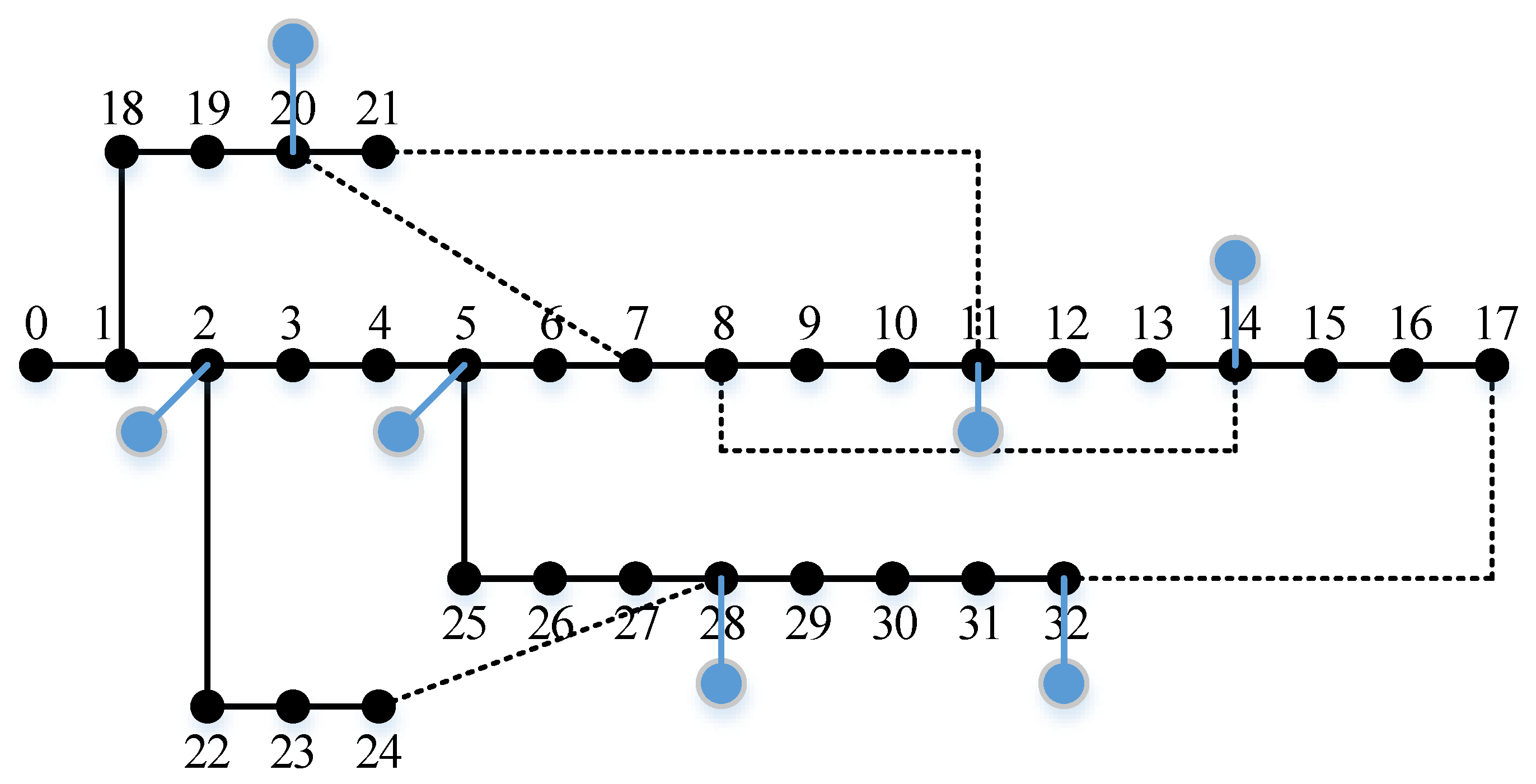
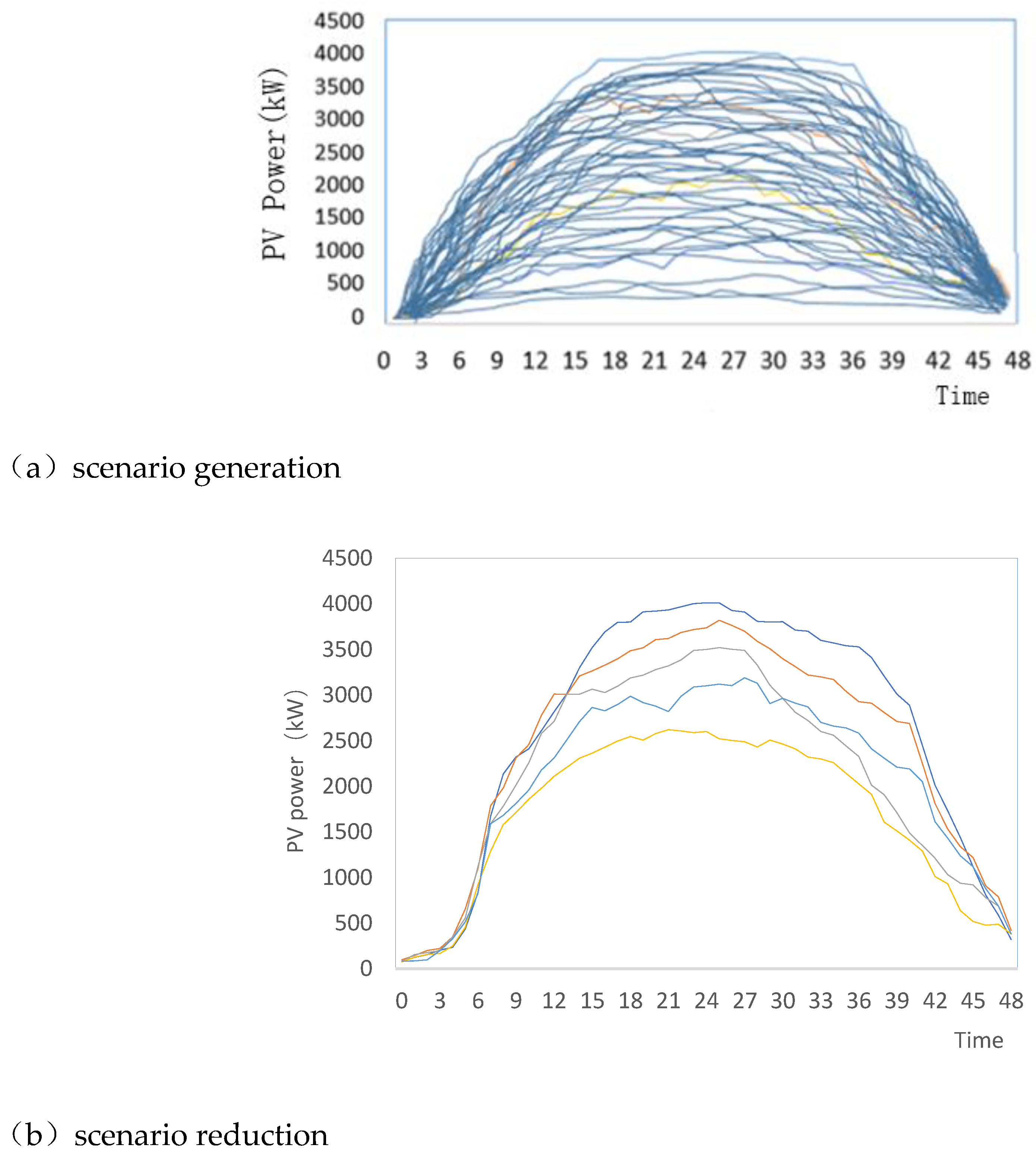
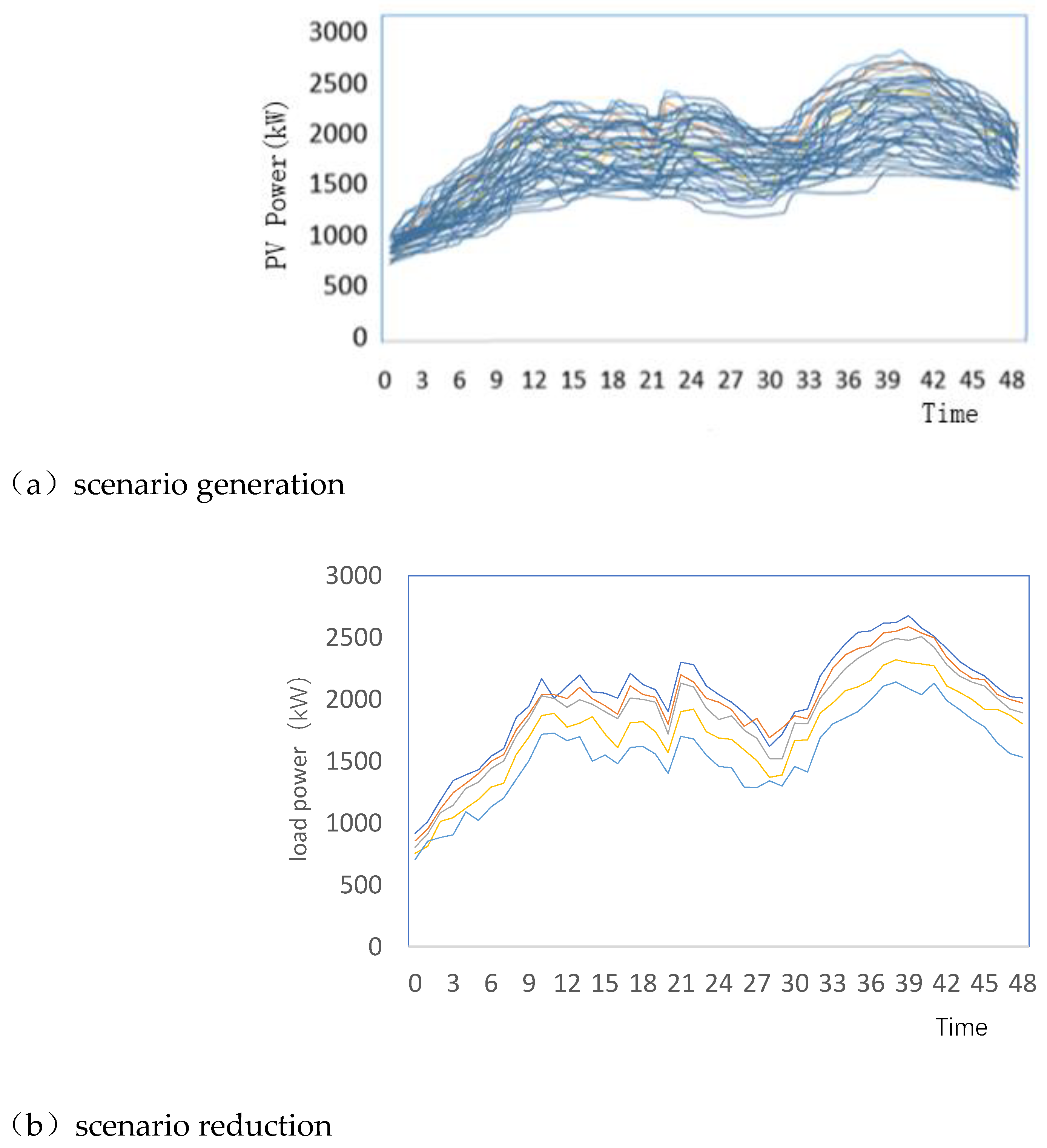
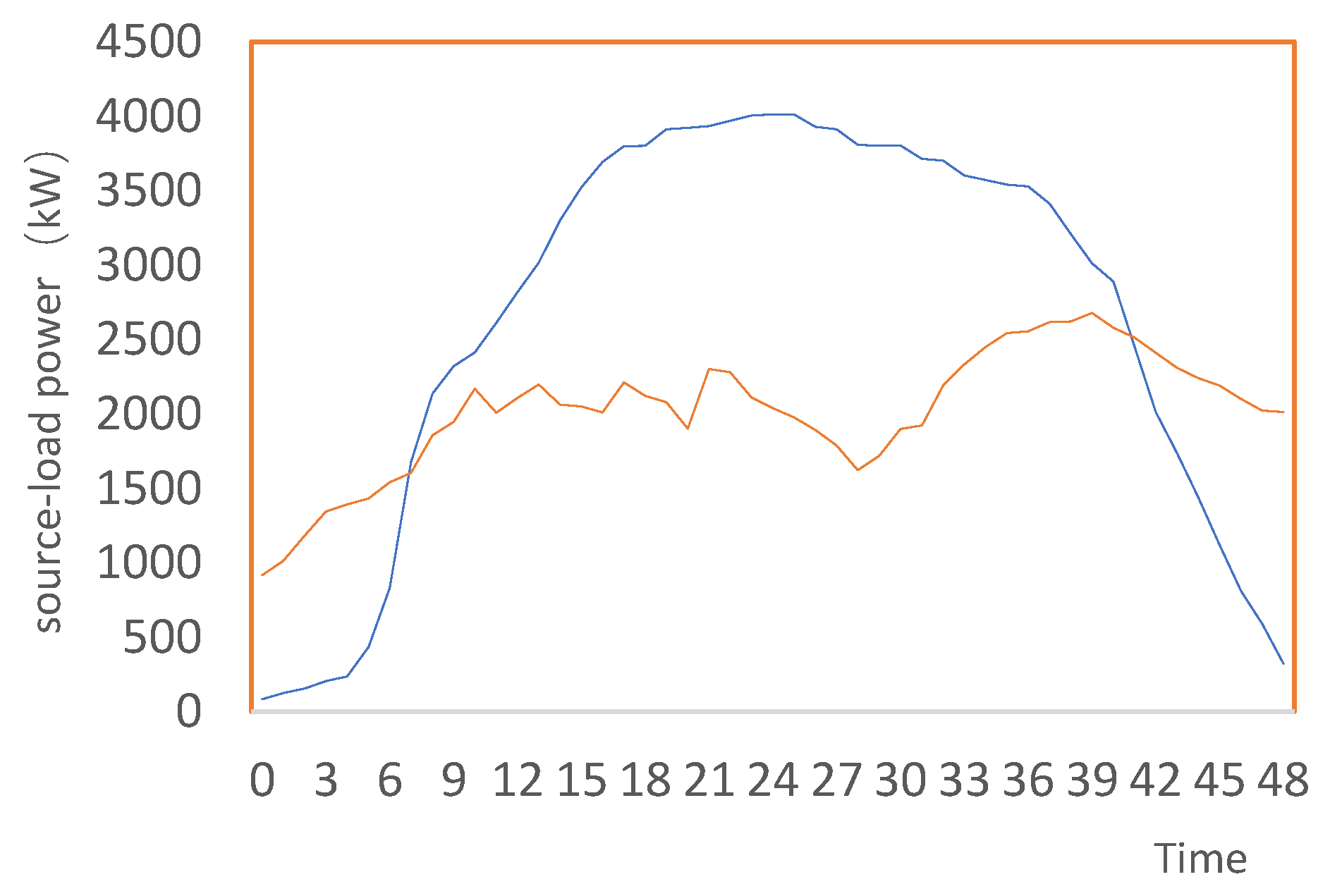
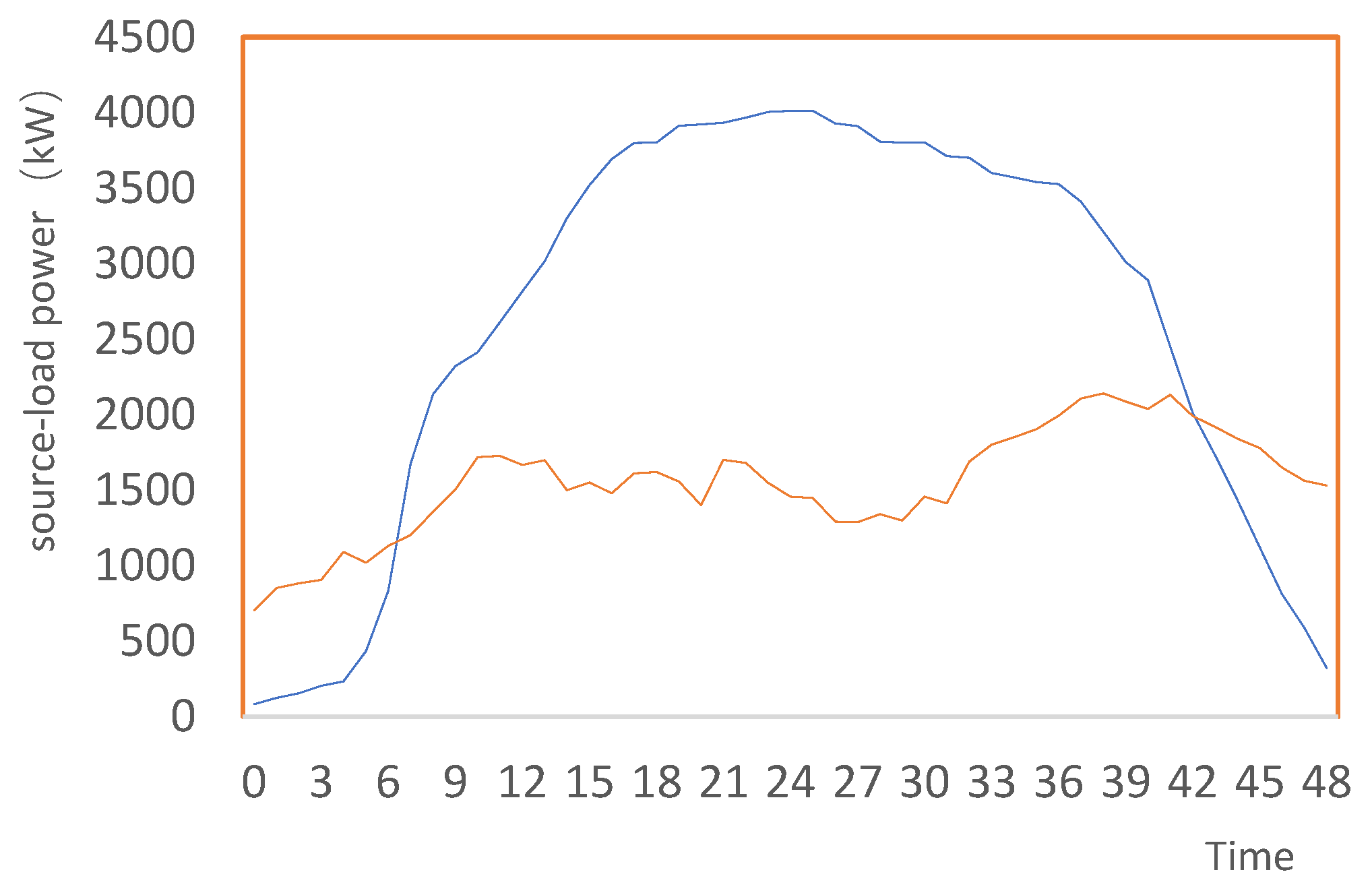
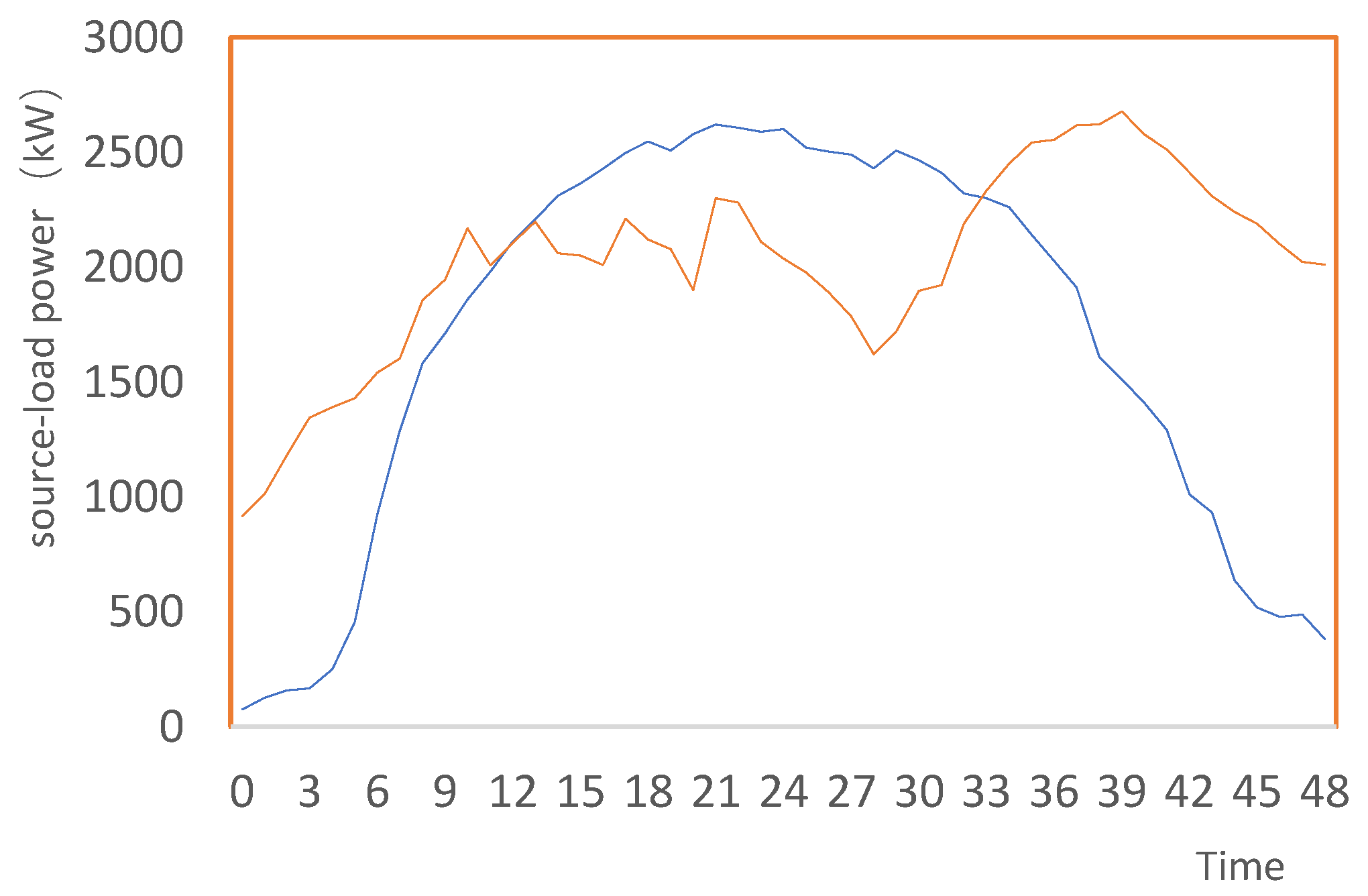
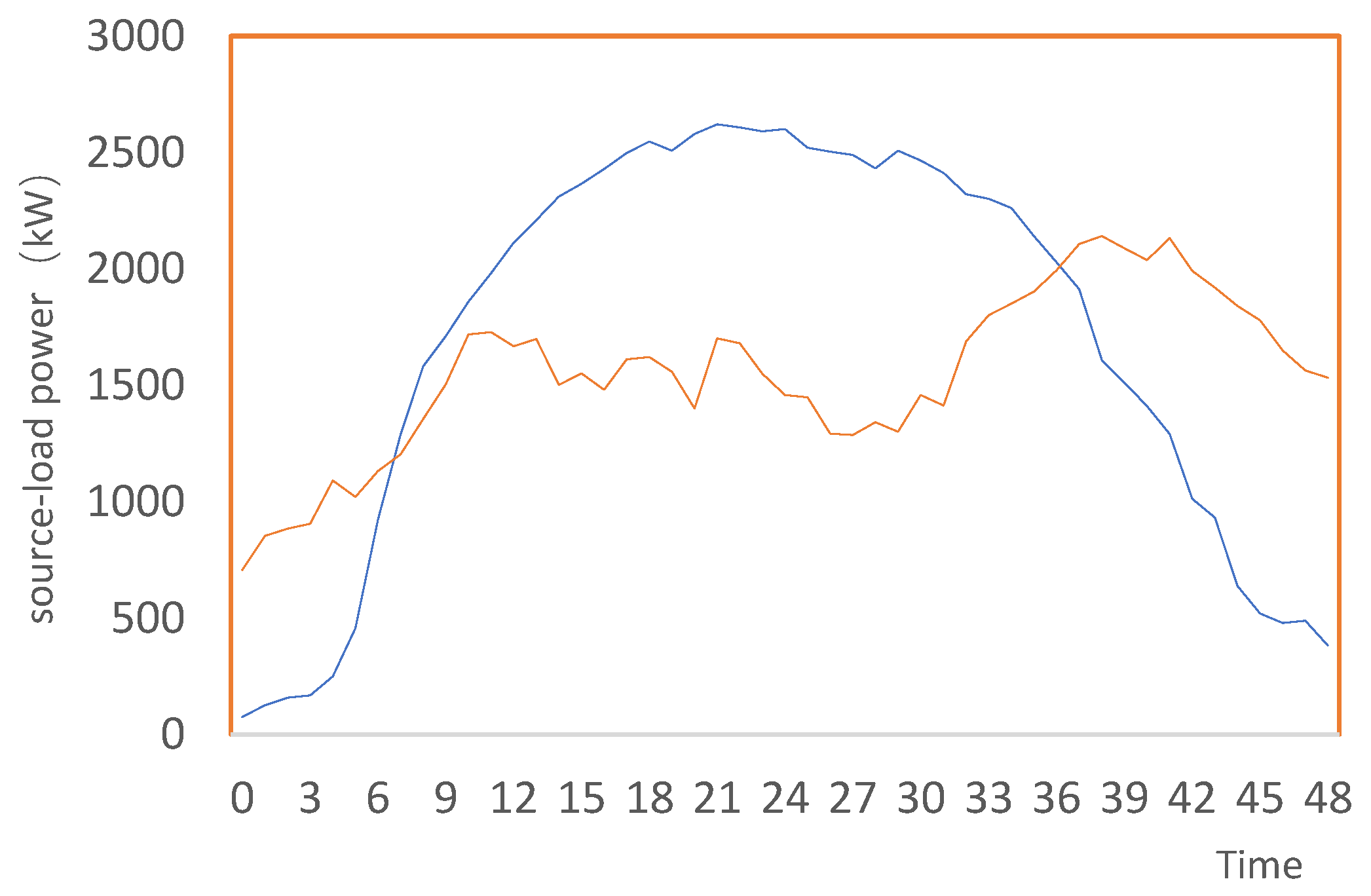
| Node | 2 | 5 | 11 | 14 | 20 | 28 | 32 |
| Capacity | 400 | 400 | 500 | 500 | 400 | 1200 | 1200 |
| Ks | Power Control(kW) | |||||
| Max | Min | Weighted average | Shifting | Stored energy | solar abandon | |
| 1 | 1.632 | 1.527 | 1.523 | 1153 | 0 | 1723 |
| 2 | 1.892 | 1.835 | 1.829 | 783 | 0 | 2437 |
| 3 | 0.931 | 0.912 | 0.903 | 1034 | 754 | 0 |
| 4 | 1.212 | 1.186 | 1.179 | 1321 | 452 | 783 |
Disclaimer/Publisher’s Note: The statements, opinions and data contained in all publications are solely those of the individual author(s) and contributor(s) and not of MDPI and/or the editor(s). MDPI and/or the editor(s) disclaim responsibility for any injury to people or property resulting from any ideas, methods, instructions or products referred to in the content. |
© 2023 by the authors. Licensee MDPI, Basel, Switzerland. This article is an open access article distributed under the terms and conditions of the Creative Commons Attribution (CC BY) license (http://creativecommons.org/licenses/by/4.0/).




